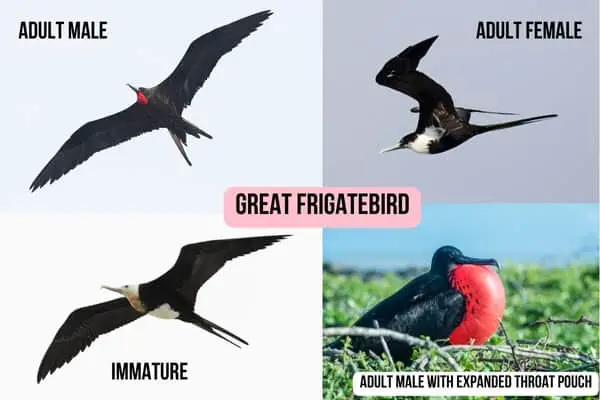Whether you are vacationing on Maui or are simply interested in the local birds, we’ve got the perfect list for you. Maui is home to a fascinating mix of native and non-native bird species from around the world. We’ve put together a list of 36 of the most commonly seen birds on the island, including pictures to help you identify them. Let’s dive into our list to get you aquatinted with some of the most common birds in Maui.
1. Common Myna
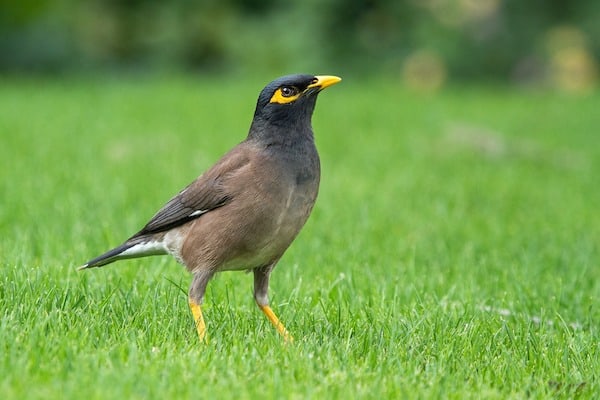
Scientific name: Acridotheres tristis
The Common Myna, also known as the Indian Myna or Indian Mynah, is a member of the starling family. Both males and females have yellow bills, legs, and skin around the eyes. They have a brown body, black head, and large white wing patches visible when they fly.
They aren’t particularly shy of humans, so they are one of the most often spotted birds on Maui since they hang out around human developed areas like the airport, hotels, beaches and parks. Common mynas are omnivorous birds that eat pretty much anything they can find, including insects, arachnids, crustaceans, reptiles, seeds, grain, and fruits. They will also probably be interested in any food you happen to drop on the ground.
In the evening, large groups of Common Mynas gather in communal roosts in large trees. They are very “chatty” birds and can be quite noisy when they all get together.
In Hawaii, Common Mynas are considered an invasive species and are known to displace native birds and deplete their food supply. They were introduced from India in the 1850’s to help control insect pests like army worms. Unfortunately their territorial behavior has led to some negative impacts on the ecosystem.
2. Zebra Dove
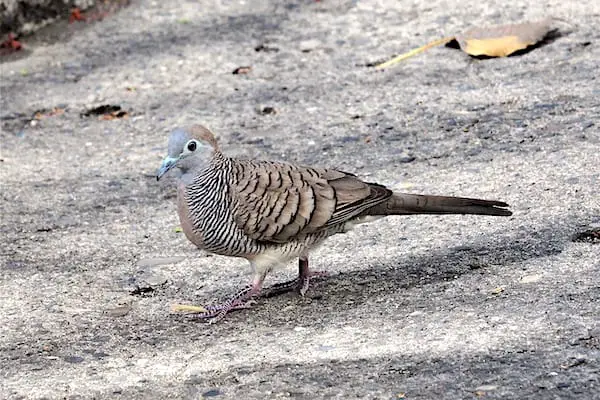
Scientific name: Geopelia striata
The Zebra Dove, also known as the Barred Ground Dove, is a small bird that is native to Southeast Asia. Their feathers are a mix of brown, gray, and black, with distinctive black and white stripes on their neck and breast. They have pink legs, and pale blue skin around their eyes. Their call is a series of rapid “coos”, and they are often found in pairs or small groups.
The Zebra Dove is primarily a seed-eating bird, but they also consume insects and small invertebrates. They are known to forage on the ground, searching for food among grasses and leaves. They are also attracted to bird feeders and will readily consume seeds that are provided for them. In Hawaii, the Zebra Dove is a common sight in urban and suburban areas, where they feed on grass seeds and insects that are found in gardens and parks.
Zebra Doves are monogamous and form long-term pair bonds. They build their nests on the ground, often in grassy areas or under shrubs. The female typically lays two eggs, which are incubated by both parents. Once the chicks hatch, they are fed by both parents until they are able to fend for themselves.
Zebra Doves were introduced to Hawaii in the 1920’s and spread quickly across the islands. They are known for being rather tame, and frequenting outdoor eating establishments. Watch out for these guys if you are at an outdoor restaurant, some are so bold they will land on tables and chairs!
3. Warbling White-Eye

Scientific name: Zosterops japonicus
The Warbling White-eye, also known as the Japanese White-eye or Mejiro, is a small songbird that is native to Japan, Taiwan, and the Philippines. Their feathers are a mix of green, yellow, and white, with a distinctive white ring around their eyes. The Warbling White-eye has a small, pointed beak that is ideal for probing flowers and fruit. They have a melodious song that is often heard in the forests and gardens of Hawaii.
Warbling White-eyes are primarily a nectar and fruit-eating bird, but they also consume insects and small invertebrates. They are also attracted to bird feeders and will readily consume sugar water that is provided for them.
Warbling White-eyes were introduced to O’ahu in 1929 and quickly spread to all the islands. They have been so successful, that they have been considered Hawaii’s most abundant land bird since the late 1980’s. Unfortunately they have been identified as a vector for avian parasites that adversely affect native Hawaiian birds like honeycreepers.
Look for them among leaves and flowers in gardens, parks and forests.
4. House Sparrow

Scientific name: Passer domesticus
The House Sparrow is a small bird that is native to Europe, Asia, and North Africa. They have since been introduced to many parts of the world, including Hawaii. Both sexes have a mix of brown, gray, and black feathers. The male has a distinctive black bib on its throat, and rufous patch at the nape of the neck, while the female has a plain brown head.
House Sparrows are primarily seed-eating birds, but they also consume insects and small invertebrates. They are known to forage on the ground, usually in a group, using their beaks to search for food among the grass and leaves. A common sight in urban and suburban areas, they are very at-home with man-made structures. You may see them nesting in storefront signs or other nooks and crannies of buildings.
They love to search for human food in high-traffic areas like beaches, outdoor restaurants and cafes. Don’t walk away from your plate if eating outside, or you might come back to find a House Sparrow sharing your meal!
House Sparrows are social birds and are often found in large flocks. They are also known for their aggressive behavior towards other birds, often competing with native species for food and nesting sites.
5. Spotted Dove

Scientific name: Spilopelia chinensis
The Spotted Dove, also known as the Indian Turtle Dove, is a small bird that is native to Asia and brought to Hawaii in the 1800s. They have an overall soft, rosy coloring with brown wings and a distinctive black patch on their upper back covered in white dots.
Spotted Doves are primarily seed-eating birds, but they also consume insects and small invertebrates. They forage on the ground in open fields, parks, forests and gardens. They are fairly tame and comfortable in urban and suburban settings, so you’re likely to run into one on any of the islands.
Spotted Doves are monogamous and form long-term pair bonds. In Hawaii they breed year-round, building their nests in trees or shrubs, using grass, twigs, and other materials to create a sturdy structure. As part of courtship, males will bow, coo, and make aerial displays.
6. Cattle Egret

Scientific name: Bubulcus ibis
The Cattle Egret is a medium-sized bird that is native to Africa and Asia, but can be found in many parts of the world today. Their feathers are mostly white, although you may see a buffy orange-brown patch on their head, breast, back and neck during breeding season. The Cattle Egret has a long, pointed beak that is yellow in adults and darker in juveniles. Their legs are yellow when breeding, and black when not.
Cattle Egrets are primarily insect-eating birds. They are known to forage in fields and pastures, often following livestock such as cows and horses to catch insects that are disturbed by their movement. In fact, sometimes they will perch right on their back! In Hawaii, the Cattle Egret is a common sight in agricultural areas and grasslands. Unlike most egrets, they prefer to get their food in dry areas, but you’ll still see them near beaches and ponds throughout Maui.
Cattle Egrets have been introduced to many regions to control insect populations in agricultural areas, and have even been used to control pests on golf courses. They were brought to Hawaii in the 1950’s and 60’s to help control cattle pests, and have thrived.
7. Pacific Golden-Plover

Scientific name: Pluvialis fulva
Finally, we have made it to a bird considered to be native to Hawaii! These plovers come to Hawaii to do what many of us would like to do, spend the winter. The Pacific Golden-Plover (locally called kolea), typically arrive in Hawaii in late August or early September, flying in from their breeding grounds in the Arctic tundra. During their migration, they fly non-stop for up to 88 hours, covering distances of up to 4,000 km.
For most of the winter their coloring will be a pale belly, with a back heavily mottled in brown, white and hints of gold. Find them on open lawns, golf courses and fields. At night they are known to roost in flocks, sometimes on hotel rooftops. They are also attracted to wetlands and mudflats, where they can find a variety of insects and invertebrates.
As spring approaches, they put on their “tuxedos”. Males sport solid black feathers on their face and belly, while females will also add black to those areas, but in patchwork instead of solid. Come April, they begin their migration back to their breeding grounds in the Arctic.
8. Northern Cardinal

Scientific name: Cardinalis cardinalis
Native to North America, many American visitors may be surprised to see this cardinal in Hawaii. They were introduced to Hawaii in the early 1930s as part of an effort to introduce new bird species to the islands as a way to add more diversity to the bird population. Although that may not have been the best idea for the native bird species, these cardinals are generally well loved for their color and cheerful song.
Males are bright red with a black face mask, while the females have a more subdued brownish-red coloration. Both sexes have a distinctive crest on their head and a short, conical orange beak. Northern Cardinals are primarily seed-eating birds, but they also consume insects and small invertebrates.
They are attracted to bird feeders and will readily consume seeds that are provided for them. They have several variations of a melodious, whistling song. Males sing loudly from high perches, and are among the first birds you will hear in the morning.
Northern Cardinals can be found throughout most of Maui, and are often seen at resorts.
9. House Finch
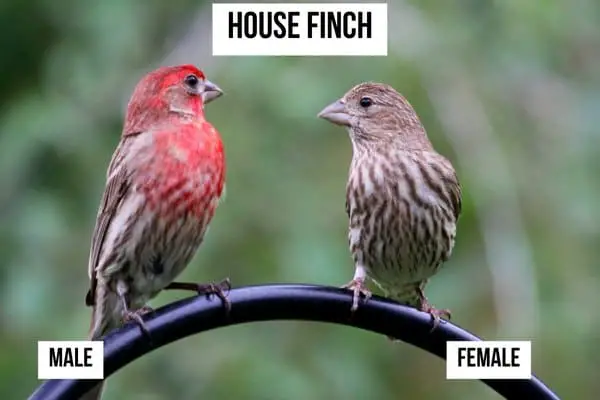
Scientific name: Haemorhous mexicanus
The House Finch is a small songbird that is native to North America. Both males and females are heavily streaked with brown and cream, but males also sport a red wash on the head and chest. Interestingly, males can sometimes show orange and yellow coloring instead of red, and this is more commonly seen in Hawaii than on the mainland.
The red coloring in their feathers come from carotenoid pigments in the foods they eat while they are going through the molting process. In Hawaii, House Finches really enjoy eating the tropical fruit papaya. So much so, that some locals call them “papaya birds”. Papaya doesn’t have enough carotenoids to produce dark red feathers, so House Finches that consume a lot of papaya tend to be more orange or yellow.
They were introduced to Hawaii in the mid 1800’s and are now common on all the main islands. House Finches mainly eat seeds, grains and berries. They are known to forage on or in vegetation, and readily visit bird feeders. They like mixed seeds, sunflower or like many finches, thistle seed. House Finches are a social bird and are often found in flocks, especially during the winter months.
10. Red-crested Cardinal
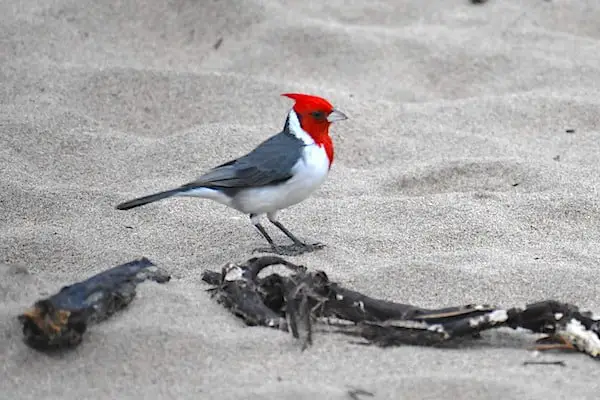
Scientific name: Paroaria coronata
Another cardinal you can find on Maui is the Red-crested Cardinal, native to South America. Unlike the Northern Cardinal, all adults of this species have the same coloration. They sport a white underbelly, slate gray wings and back, and bright red chest and head with a tall crest. If you see a bird that looks just like this but with a brown head instead of red, that is a juvenile.
Despite its name and similar body shape, these birds are actually members of the tanager family and aren’t true cardinals.
Red-crested Cardinals are primarily seed-eating birds, but they also consume insects and small invertebrates. In Maui, look for them in gardens and parks, especially beach parks. While they can be found inland, most sightings tend to occur along the coast.
11. Black-necked Stilt
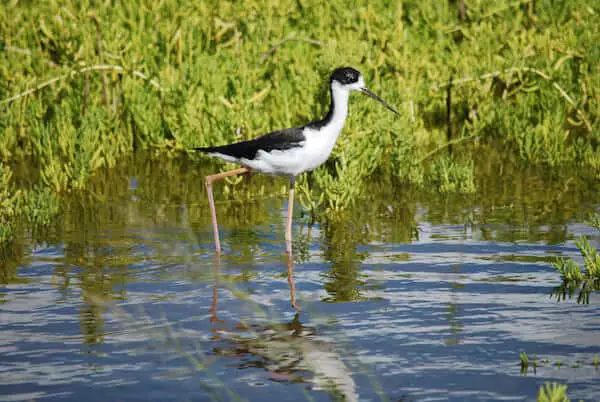
Scientific name: Himantopus mexicanus (knudseni)
Black-necked Stilts are medium-sized wading birds native to North and South America. The Black-necked Stilt has quite a distinctive look, with its black and white plumage, long pink legs and long thin bill. The Black-necked Stilts that live in Hawaii are often considered their own subspecies, the Hawaiian Black-necked Silt or Ae’o.
They use their long, stilt-like legs to wade in shallow water while probing the mud with their beak for food. Insects, crabs, worms, and fish are all on the menu, so you’ll find them foraging in shallow water bodies. In proportion to their body size, they have the second-longest legs of any bird species.
Most of the Hawaiian stilts live on Maui, Oahu and Kauai. While the North and South American populations are fine, the Hawaiian stilt is considered endangered. Loss of wetland habitat and introduced mammal predators like cats, dogs and mongoose are some of the main causes.
Some good spots to find them on Maui are the Kanaha Pond Wildlife Sanctuary and Kealia Pond NWR.
12. Black-crowned Night-Heron
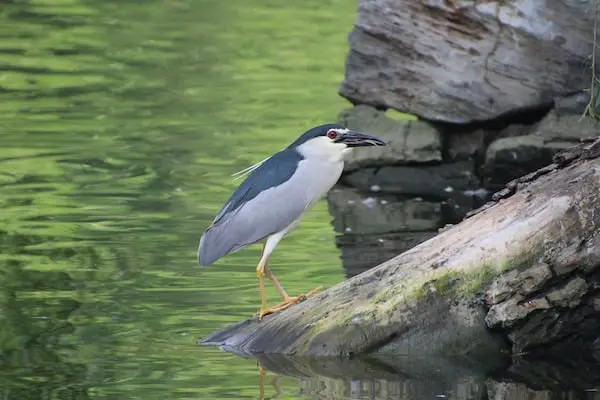
Scientific name: Nycticorax nycticorax
The Black-crowned Night-Heron is a medium-sized wading bird that is native to several continents, and is considered a native species in Hawaii. Locally they are called ‘auku’u. Unlike many herons with long legs and necks, the Black-crowned Night-Heron has a squat shape with shorter legs. They have a gray body, with a black crown and back, and red eyes. During the breeding season, a few long white feathers stream from the back of their head. Juveniles are brown and spotted.
They hunt for fish, shellfish, frogs, lizards, mice, insects and even smaller birds. Find them near ponds, marshes, streams and shoreline, remaining still while watching for prey then striking out with their sharp beak.
Black-crowned Night-Herons are a solitary bird and are often seen alone or in small groups. They build their nests in trees or shrubs.
13. Hawaiian Coot
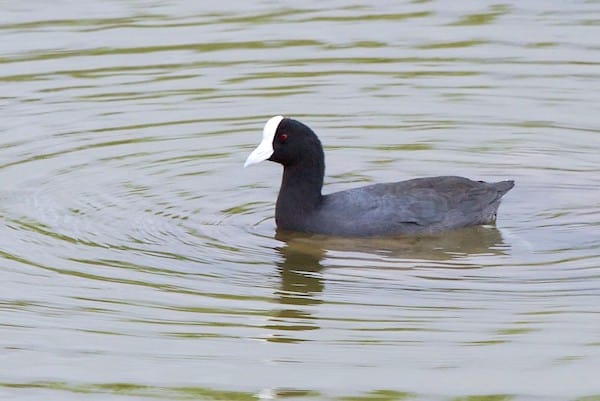
Scientific name: Fulica alai
Known as ‘alae ke’oke’o in Hawaiian, this coot species in only found on Hawaii. With their dark body, white beak and white forehead shield, they look very similar to the more widespread American coot. However the frontal shield on the Hawaiian coot is much larger and more rounded. It can appear all white or dark red.
Find these coots in wetlands, ponds, marshes, canals and in grassy areas adjacent to water such as lawns and golf courses. Coots have large, lobed toes that help them swim, but are better for walking on aquatic vegetation and land than fully webbed feet.
The Hawaiian coot was listed as a federally endangered species in 1970. You my get some lucky golf course sightings, or look for them with the Black-necked Stilts at the Kanaha Pond Wildlife Sanctuary and Kealia Pond NWR.
14. Gray Francolin
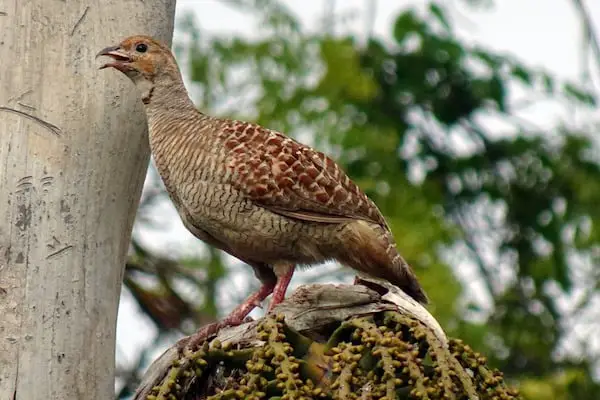
Scientific name: Ortygornis pondicerianus
The Gray Francolin, also known as the Grey Partridge, is a medium-sized game bird that is native to Indian and Iran. Introduced to Hawaii, they are a common sight on golf courses, resort lawns, and roadsides in Maui, especially at dawn and dusk.
Their plumage is a mix of gray and brown, with fine barring along the neck and underparts, and a orange-tinted face.
Gray Francolins are primarily seed-eating birds, that forage on the ground. They can fly but only do so for short distances, preferring to stay on the ground. These Francolins are social birds and are often found in pairs or small flocks. They are known for their loud call, which is often heard in the early morning.
15. Apapane
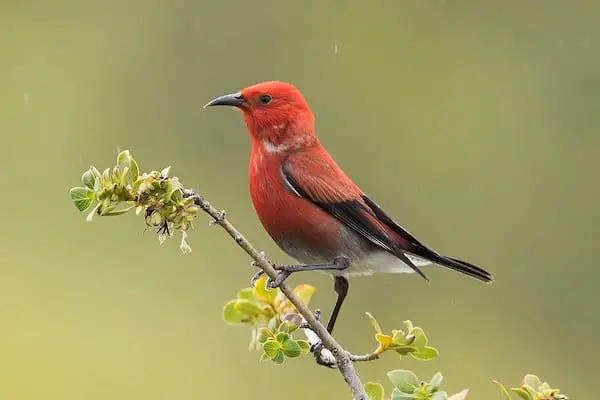
Scientific name: Himatione sanguinea
The Apapane is the most abundant honeycreeper in Hawaii and is found on most of the main islands, including Maui. They may be the most populous native Hawaiian bird. Adults are red with black on their wings and tail, and a white patch below the tail. They have black legs and a black, slightly down-curved beak. Juveniles are brownish yellow.
Apapanes are primarily nectar-eating birds, but they also consume insects and spiders. They forage in the canopy of trees, using their beaks to sip nectar from the flowers of native plants. Often found in flocks feeding on ‘ohi’a trees. They have a long history of association with Hawaiian culture. They have been used in Hawaiian chants and songs, and are considered a symbol of love and loyalty.
The Apapane is also an important species in the ecosystem of Hawaii. They are important pollinators of native plants, and their presence is an indicator of the health of the forest ecosystem. Despite their importance, the Apapane is threatened by habitat loss and the introduction of non-native species.
To find these birds you’ll need to head for more forested areas with flowering trees. Especially areas with ‘Ohi’a lehua, the most common native Hawaiian tree. Try the Waihe’e Ridge Trail, Hanawi Natural Area Reserve and Hosmer Grove at Haleakala National Park.
16. Hawaii Amakihi
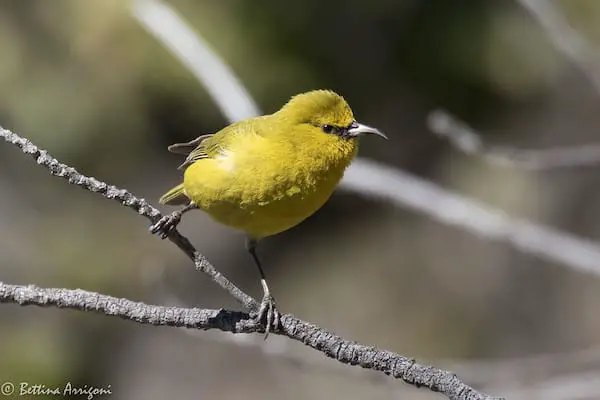
Scientific name: Chlorodrepanis virens
The Hawaii Amakihi is a small, yellow honeycreeper that is native to Hawaii. Adults look similar, with males being bright yellow and females being more of a greenish-yellow. They have a dark, curved bill and a slight dark shadow in front of their eyes.
Amakihis have a tubular tongues they use to feed on nectar, but they also consume insects, small invertebrates and can suck the juice from fruit. This species has a long breeding season that can last for up to nine months and include two broods of chicks.
Today, they are found on the Big Island, Maui and Molokai. They are able to live in various types of habitat but require forested areas, and can live at elevations up to 8,000 feet. Many of Hawaii’s native forest birds have seen a steep decline from habitat changes and avian disease, however the Amakihis have proven to be the most resilient so far. It is even thought they may be evolving a resistance to avian malaria.
On Maui, some good spots to look for them include Polipoli State Park, the Waihe’e Ridge Trail, and Hosmer Grove at Haleakala National Park.
17. Wandering Tattler

Scientific name: Tringa incana
This medium-sized shorebird is a migratory species that breeds in the Arctic regions of North America and Asia. They spend their winters in the Pacific Islands, including Hawaii, as well as in coastal regions of North and South America. During their migration, they can be found in a variety of habitats, including rocky shorelines, tidal pools, and estuaries.
During the breeding season, the Wandering Tattler has a mottled brown and white plumage, with a distinct white eyebrow stripe and a dark patch on the back of the neck. However in Hawaii you’ll mostly see their non-breeding plumage, when it changes to a more uniform gray-brown coloration. The white eyebrow stripe is still present, but the dark patch on the back of the neck is less distinct.
Wandering Tattlers are primarily insect-eating birds, but they also consume small crustaceans, mollusks, and fish. You’ll see them alone or in small groups, foraging in shallow water, using their long legs to wade and their beaks to probe the mud for food. They are also attracted to rocky shorelines and tide pools, so look for them along the coast from fall to early spring. In Hawaiian, they are known as ‘ulili.
18. Scaly-breasted Munia
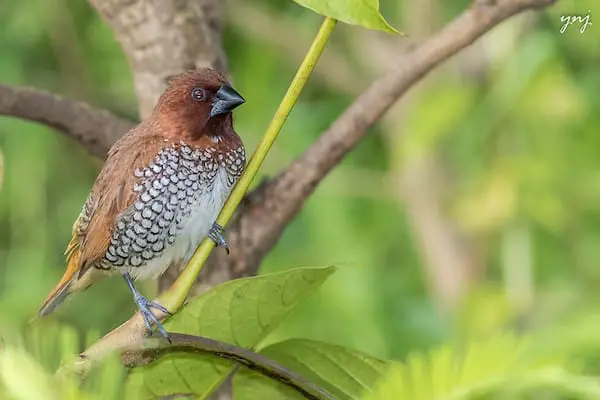
Scientific name: Lonchura punctulata
The Scaly-breasted Munia is a bird of many names. In the pet trade, they often go by the name Nutmeg Mannikin or spice finch. They are also known as “ricebirds” because of their love for eating rice grains.
This species is native to India and southeast Asia. Once introduced to Hawaii in the late 1800’s, they spread pretty rapidly to most of the islands. The Scaly-breasted Munia has a warm brown back and head, thick black beak, and white underparts with a distinctive scaly pattern.
They feed on a variety of grass seeds, including rice, millet, and other cultivated grains. Because of this they are often found in agricultural areas. They are also attracted to bird feeders and will readily consume seeds that are provided for them, such as millet, sunflower seeds, and other small seeds.
In addition to seeds, Scaly-breasted Munias also feed on small insects and invertebrates, particularly during the breeding season when they need extra protein to raise their young. They are known to feed on ants, beetles, and other small insects that they find on the ground or in low vegetation.
19. Rock Pigeon
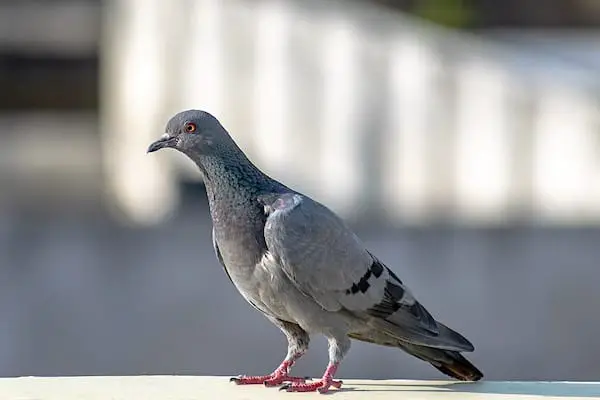
Scientific name: Columba livia
Rock Pigeons, also known as Rock Doves (or just plain “pigeons”), are a common bird species found throughout the world. They have gray-blue plumage with two black bars on the wings, green-purple iridescence on the neck, and pink feet. Although, they can display a wide variety of different colors and patterns, including mostly white. They are not native to Hawaii (or the Americas for that matter), but are common on the islands. They may have been introduced as early as 1788.
ln Hawaii, Rock Pigeons are a common sight on rocky cliffs and in urban areas, including parks, plazas, and parking lots. They are often seen perched on buildings or foraging on the ground for food. This is one type of bird you seem to run into anywhere in the world you go, even on the remote islands of Hawaii!
20. Java Sparrow
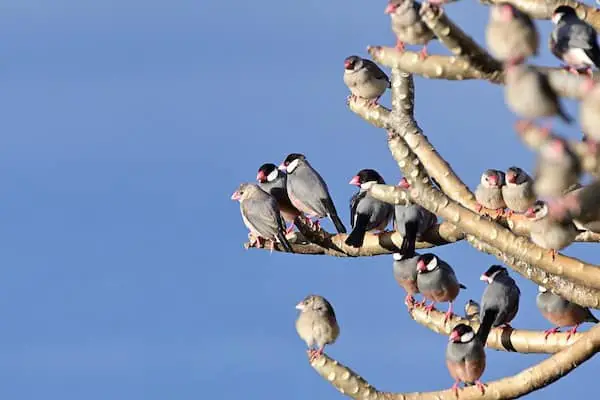
Scientific name: Padda oryzivora
The Java Sparrow, also known as the Java Finch, is a small bird that is native to Indonesia. They have since been introduced to many parts of the world, including Hawaii where they were they have spread from O’ahu in the 1960’s to most of the main islands. These social birds are often found in pairs or small flocks.
These large finches are easy to identify due to their unique coloration. They have gray bodies with rosy bellies, a black head, bright white cheek patches, a red eye and thick pink beak.
Java Sparrows are primarily seed-eating birds, and can be considered pests in rice fields and other agriculture due to their appetite. In fact, they used to be a common exotic pet bird in the continental United States until their importation was banned due to escaped birds potential threat to agriculture. In Hawaii, the Java Sparrow is a common sight in urban areas and gardens.
21. ‘I’iwi
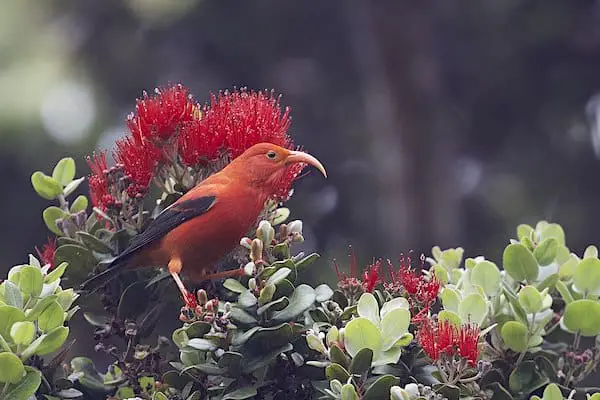
Scientific name: Drepanis coccinea
The ‘I’iwi is perhaps the most iconic Hawaiian bird. Also called the Scarlet Honeycreeper, the ‘I’iwi is the third most common native land bird on the islands. Their deep red body and black wings make them an easier bird to spot among green foliage. Their most unique feature may be their large, pale pink, curved (almost hook-shaped) beak.
This beak shape, like other honeycreepers, is designed to aid them in reaching nectar inside tubular flowers. This may sound like a little bit like a hummingbird, and you aren’t far off. In fact, their are no hummingbirds in Hawaii, and the honeycreepers have filled in the role of nectar-drinking and pollinating birds. ‘I’iwis are in the genus Drepanis, which used to contain three species of honeycreeper with deeply curved, sickle-like bills. However the ‘I’iwi is the last one remaining, with the Hawai’i mamo and the Black mamo both now extinct.
The ‘I’iwi is an important cultural symbol in Hawaii. It is considered to be a sacred bird in Hawaiian mythology, and its feathers were used in traditional Hawaiian clothing and adornments. Most ‘I’iwis today can be found in small pockets on Maui and Hawai’i Island. On Maui, head to the forests at higher elevations around Haleakala on the eastern half of the island.
22. Ruddy Turnstone
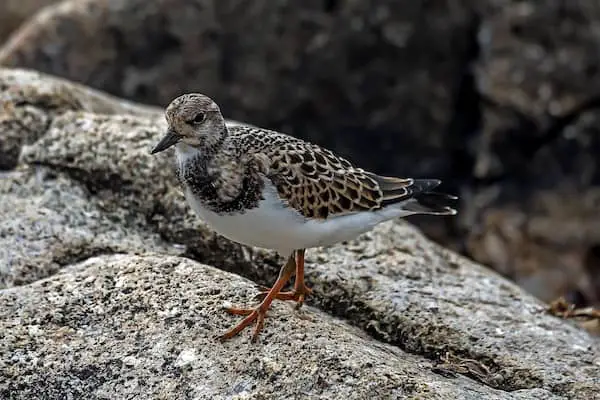
Scientific name: Arenaria interpres
Ruddy Turnstones are common shorebirds that breed in the Arctic regions of North America and Eurasia. They migrate to spend their winters in coastal regions of North and South America, as well as in the Caribbean and other tropical regions like Hawaii. These common winter visitors to the islands are called ‘akekeke.
When you see them in Hawaii, they will be in their non-breeding plumage. They have a pure white belly, orange legs, a brown and black mottled head and back, and a faint black band along the chest. They have short, pointed beaks that are ideal for foraging for small invertebrates and crustaceans, which make up the majority of their diet.
Find them in groups along beaches and rocky shoreline. While you probably won’t be able to notice from afar, their feet are a bit spiny with sharp nails that help them grip slippery wet rocks. Look for them especially in areas where seaweed, shells and other debris washes up and deposits along the shore.
22. Sanderling
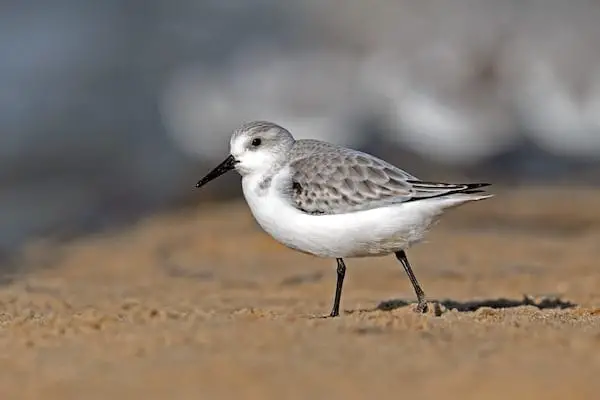
Scientific name: Calidris alba
Sanderlings are migratory birds that breed in the Arctic regions of North America, Europe, and Asia. They spend their winters in coastal regions of North and South America, as well as in Africa, Australia, and other parts of the world. They are one of the most widespread shorebirds in the world, and include most of the Hawaiian islands in their wintering grounds.
Sanderlings have a small, compact body with a short, straight beak that is ideal for foraging in the sand for small invertebrates and crustaceans. During the breeding season, the birds have rusty brown on their head and back, but this fades out to white underparts and a soft brownish-gray back during the winter. Their legs and bill are black.
Look for them foraging along the waters edge on sandy beaches. You’ll often see them alone or in small groups, scurrying to probe the sand as the waves retreat, then rush back as the waves return. Crabs, amphipods, worms, mollusks and crustaceans are all on the menu.
23. Red Junglefowl
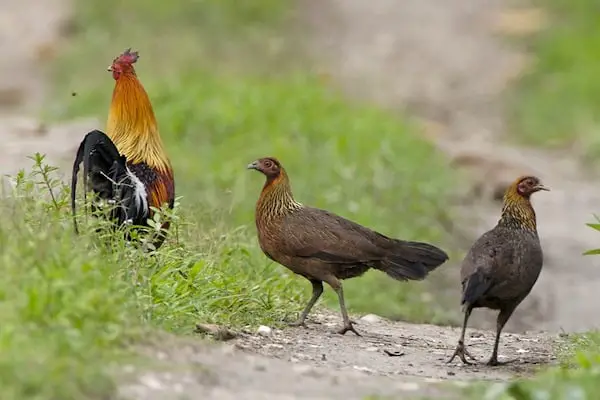
Scientific name: Gallus gallus
The Red Junglefowl, also known as Moa, is a forest-dwelling chicken introduced to Hawaii by Polynesian settlers who arrived on the islands around 1,500 years ago. The settlers brought with them a variety of plants and animals, including chickens, which were used for food and as a source of feathers for clothing and adornments.
The male Red Junglefowl, also known as the rooster, is larger and more colorful than the female. They have a bright red comb on top of their head, as well as a long, curved tail feathers that are used in courtship displays. The male’s plumage is also more colorful, with a mix of red, orange, gold and metallic green. The female Red Junglefowl, also known as the hen, is smaller and less colorful than the male. They have a brown body and slightly lighter tan neck which helps to camouflage them in their natural habitat.
Over time, the Red Junglefowl became established in Hawaii and began to thrive in the islands’ warm and humid climate. Today, the Red Junglefowl is a common sight in Hawaii, particularly along roadsides and in rural areas. Some are still kept by locals, while others are wild.
24. Ring-necked Pheasant
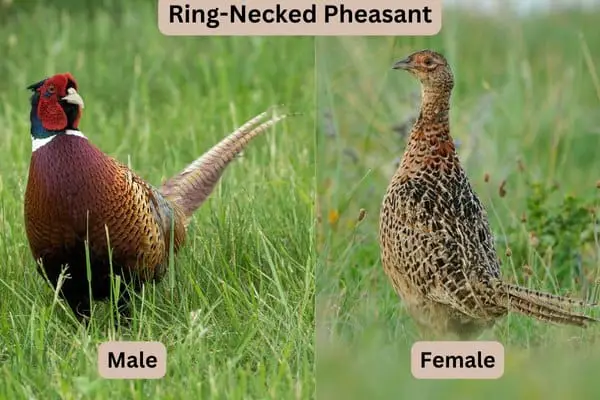
Scientific name: Phasianus colchicus
Ring-necked Pheasants are a non-native bird species that was introduced to Hawaii starting in the late 1800’s as a game bird. They are now established in many parts of the islands, particularly on the island of Hawaii.
Ring-necked Pheasants are large, colorful birds with a distinctive appearance. The males have a bright, iridescent green and blue plumage on the head, neck, and upper body, with a white ring around the neck and a long, pointed tail. The females have a more subdued brown and tan plumage, with mottled markings on the body and a shorter tail.
Ring-necked Pheasants are primarily ground-dwelling birds, and are often found in grassy areas, shrublands, pastures and agricultural fields. They are omnivorous, feeding on a variety of foods including seeds, insects, and small invertebrates. They are also known to consume crops such as corn and wheat, which can sometimes lead to conflicts with farmers.
Sightings can occur in many areas of Maui, but most are in the eastern half of the island. In fact, most people actually spot them on their way to or from the Haleakala summit. Keep your eyes peeled along the roadside, in the open grassy areas while driving along the Haleakala Highway.
25. Maui Alauahio
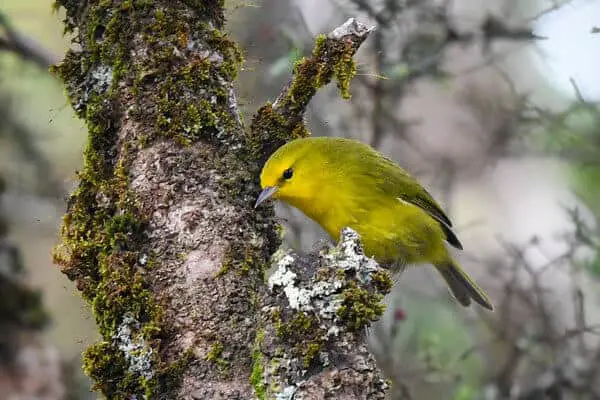
Scientific name: Paroreomyza montana
The Maui Alauahio is a small bird species that can only be found on Maui. Historically, they likely also lived on Molokai, Lanai and Kaho’olawe. They have yellow and olive-green plumage, with a faint black mask around the eyes and a short, pointed beak. Like a few other birds on this list they are honeycreepers, but don’t have a long or curved bill.
Maui Alauahios are primarily insectivorous, feeding on a variety of small insects and invertebrates that they find in the trees and shrubs where they forage. Searching behind lichen and bark, they hunt for moths, lacewings, spiders, beetles and leafhoppers. They are known for their acrobatic behavior, hopping and flitting through the branches in search of food.
Unfortunately, Maui Alauahio are an endangered species, with only around 500 individuals remaining in the wild. They are threatened by habitat loss and degradation, as well as by introduced species such as rats and mosquitoes that carry avian diseases. Three groups of them exist in east Maui above 900 feet in conservation managed areas. Like the other honeycreepers on this list, Polipoli State Park and Hosmer Grove at Haleakala National Park are some of the best spots to look for them.
26. Hawaiian Goose (Nene)
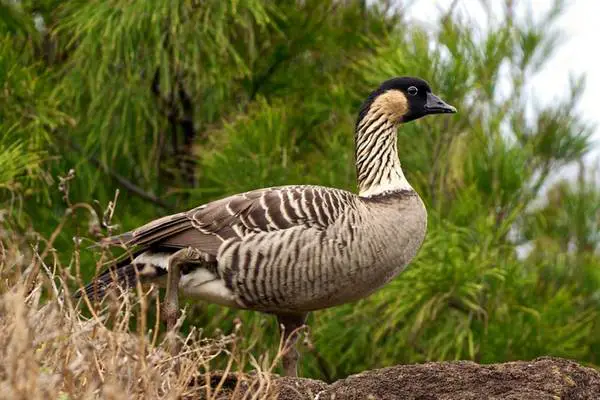
Scientific name: Branta sandvicensis
The Hawaiian Goose, also known as the Nene, is a medium-sized goose species that is endemic to Hawaii. Nene’s have a black face, buffy cheek patch, barred brown and cream body. Their neck feathers have a unique look, cream colored with deep grooves and ridges that give it the appearance of brown streaks.
They spend most of their time on the ground, but they are able to fly. Having the longest breeding season of any goose, 7 months, females build the nests and lay 1-5 eggs at a time. Nene graze on various types of plant materials, including leaves, grasses, shrubs, flowers, fruit and seeds.
It is believed that this species evolved from the Canada Goose, which likely wound up in Hawaii 500,000 years ago. Today, the Hawaiian Goose is an endangered species, with only around 2,000 individuals remaining in the wild. They are threatened by habitat loss and degradation, as well as by introduced species such as rats and mongooses that prey on their eggs and young.
Interestingly, these geese were breed in captivity in England starting in the 1950’s and reintroduced to various protected areas in Hawaii as part of a conservation effort. This likely saved the Nene from extinction. Listen for their honking call, and you may see them at parks and golf courses around ponds, at beaches, or Haleakala National Park.
27. African Silverbill
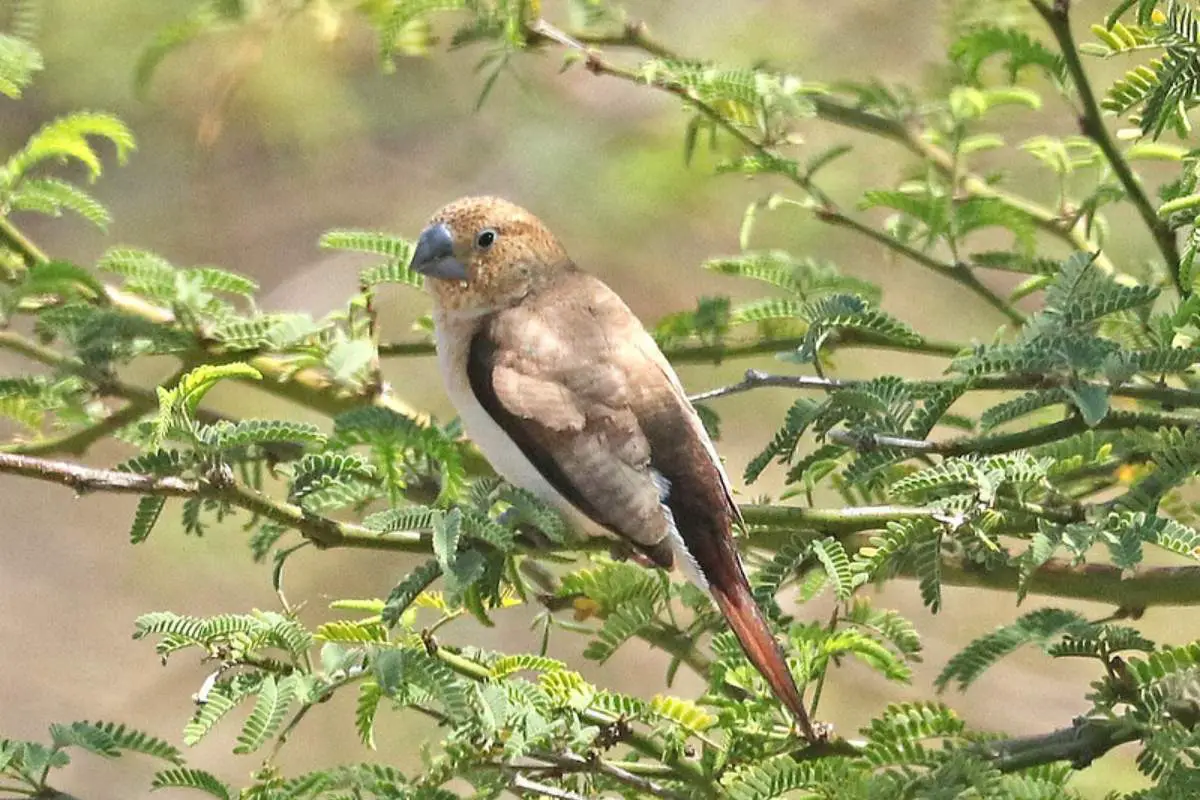
Scientific name: Euodice Cantans
The African Silverbill, also known as the Silverbill Finch, is a small bird species that is native to sub-Saharan Africa. The first records of this bird show up in Hawaii around 1970. The African Silverbill has a thick, silver-gray beak, a cream colored belly, and tawny body with ruddy tail.
African Silverbills are primarily seed-eating birds, feeding on a variety of grass seeds and other small seeds that they find on the ground or in the trees. Often described as tame and sociable, they have often been kept as pets. In the wild, find them perches in trees in groups, sometimes sitting huddled together. They have a interesting metallic chirp, sometimes described as sounding like tinkling bells or two coins being rubbed together.
Look for them around lowland areas along the northern and western parts of the island.
28. Red-billed Leiothrix
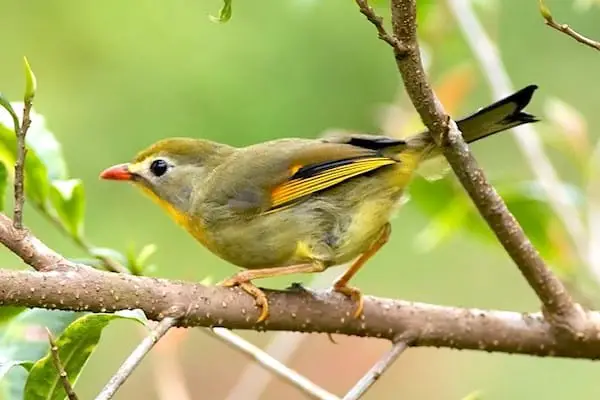
Scientific name: Leiothrix lutea
The Red-billed Leiothrix is a small, colorful bird native to the Himalayas and parts of Southeast Asia. Many nicknames have been assigned to this little songster, including Chinese hill robin, Pekin robin and Japanese nightingale. They have an olive-yellow body with a yellow-orange chest, yellow streaking on the wings, an orange beak, white dusting around the eye and a dark tail tip.
Red-billed Leiothrixes are primarily insectivorous, feeding on a variety of small insects and invertebrates that they find on the ground or in the trees. They are known for their melodious and complex songs, which are used to establish territory and attract mates. Known to be secretive, they like to remain hidden in foliage but are always moving around and singing. You may also hear them giving a scolding call when people get too close.
They were introduced to Hawaii in 1918 and spread to most forested areas. They eat insects and fruits, helping to disperse seeds throughout their habitat. They are most common in forested areas on eastern Maui.
29. Northern Mockingbird

Scientific name: Mimus polyglottos
If you’re visiting Hawaii from North America, this species may be familiar to you. In fact in the USA, they are the state bird for five different states. Mockingbirds have a gray and white plumage, with black and white wings and long tail feathers. They mainly eat small insects and invertebrates that they find on the ground or in the trees. They are also known to eat fruits and berries, particularly during the winter months when insect prey is less abundant.
Northern Mockingbirds are known for their complex and varied songs, which can include imitations of other bird species, as well as sounds from the environment such as car alarms and sirens. They are also territorial birds, and will defend their territory aggressively against other birds, animals and people.
Northern Mockingbirds were introduced to Hawaii in 1928 to help control pest insects and for their beautiful songs.
30. Eurasian Skylark
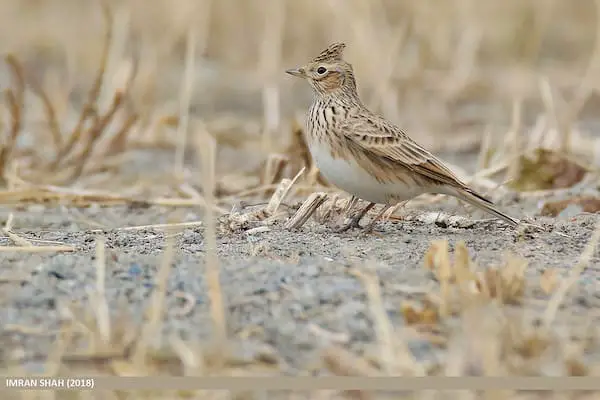
Scientific name: Alauda arvensis
The Eurasian Skylark is native to Europe and Asia. They have a white belly and tan body with delicate, fine dark brown streaking and a head crest. Eurasian Skylarks feed on a variety of small insects and invertebrates that they find on the ground or catch in the air. They are also known to eat seeds and grains, particularly when insect prey is less abundant.
Eurasian Skylarks are known for their melodious and complex songs, which are used to establish territory and attract mates. They are also known for their acrobatic flight displays, during which they soar high into the air and sing while hovering in place before descending back to the ground.
They were introduced to the Hawaiian islands in the late 1800’s and early 1900’s. Often heard rather than seen, they like grassy areas in higher elevations in Hawaii.
31. Chinese Hwamei

Scientific name: Garrulax canorus
The Chinese Hwamei, also known as the Melodious Laughingthrush, is native to China and Southeast Asia. It is said that they were originally kept as caged birds on O’ahu but were released by their owners during a fire. They have a warm brown body with a white “comma” around each eye.
Chinese Hwamei are mainly insect eaters feeding on a variety of small insects and invertebrates that they find on the ground or in the trees. They are also known to eat seeds and fruits.
What these birds are best known for are their melodious and complex songs. They sing loud, varied songs that can include harsh notes, whistles and mimicry of other bird songs. This singing can be used in mating, claiming territory or just communication with other Hwamei in their social group.
In their native range, Chinese Hwamei are often kept as pets and trained to sing. They are valued for their beautiful songs and are considered a symbol of good luck and prosperity. They may be secretive and hard to spot in Maui forests, but you won’t miss hearing them if one is singing nearby.
32. Great Frigatebird
Scientific name: Fregata minor
Great Frigatebirds are large seabirds (wingspans up to 7.5 feet) that are found in tropical and subtropical regions around the world, most commonly the Pacific and Indian Oceans. Therefore, they are considered native to the Hawaiian Islands. You’ll most likely notice frigatebirds soaring in the sky along the coasts. They have a distinctive shape, with long narrow wings and a deeply forked tail.
Male Great Frigatebirds have black plumage with a greenish sheen. They have red throat pouch that they can inflate during courtship displays, which makes them appear even larger and more impressive. Females also have dark plumage have a white breast, lighter beak and no throat pouch. Immature Great Frigatebirds look very similar to females, but they have a white head and more white on the belly.
Hawaiians call this bird ‘iwa, which means “thief”. This is in reference to a behavior they sometimes display where they will harass other flying seabirds until they drop their catch, then swoop down and steal it.
Great Frigatebirds are primarily pelagic, meaning they spend most of their time at sea, but they also nest on islands and coastal cliffs. They build their nests out of sticks and other materials and lay a single egg per breeding season. These birds have a unique ability to fly for long periods of time without landing. They have been known to stay aloft for up to two months at a time, using air currents and thermals to stay in the air.
33. Japanese Bush Warbler
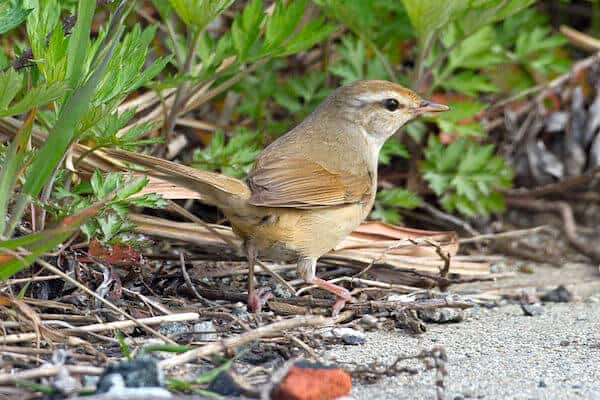
Scientific name: Horornis diphone
The Japanese Bush Warbler, also known as the Uguisu, is a small bird native to Japan and parts of East Asia. They were introduced to Hawaii on Oahu in the early to mid 1900’s and have since spread to many of the islands, including Maui. Adults of both sexes look the same, with plain olive-brown plumage, a pale throat and chest, a dark line through the eye and white line above the eye.
Japanese Bush Warblers eat a variety of small insects and invertebrates that they find in the underbrush and trees. They tend to prefer thick vegetation, staying hidden in thickets, scrubland and forest understory. Because they are small and well-camouflaged, they can be hard to spot in the wild.
However, they do have melodious and complex songs, which are often compared to the sound of a flute. Their songs are an important part of Japanese culture and are associated with the arrival of spring and the start of the new year.
34. Chestnut Munia
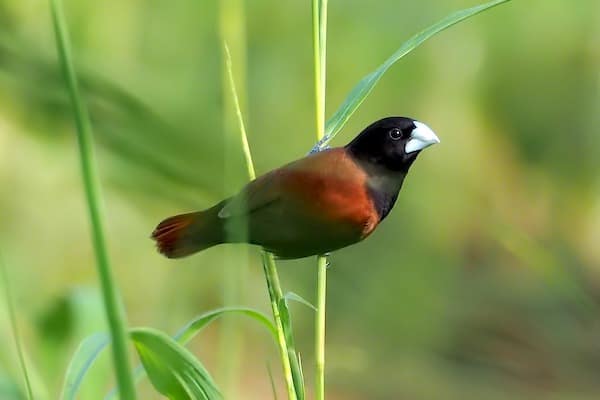
Scientific name: Lonchura atricapilla
The Chestnut Munia, also known as the Black-headed Munia or Nutmeg Mannikin, is a small bird species native to Asia and parts of Africa. They are handsome looking birds with a black head and neck, a chestnut-colored body and a thick silver-blue beak. These munias likely arrived on Hawaii as pets. Look for this species in lowland areas, mainly in central and eastern Maui.
Chestnut Munias are primarily seed-eating birds, feeding on a variety of grass seeds and other small seeds that they find on the ground or in the trees. Like the Scaly-breasted Munias earlier on this list, they can be found in grassland and agricultural areas, although they tend to prefer slightly wetter habitat.
Chestnut Munias are social birds, often living in flocks and communicating with each other through a variety of calls and vocalizations. They are also known for their acrobatic flight displays, during which they fly in synchronized patterns and perform aerial acrobatics.
35. Short-eared Owl (Hawaiian)
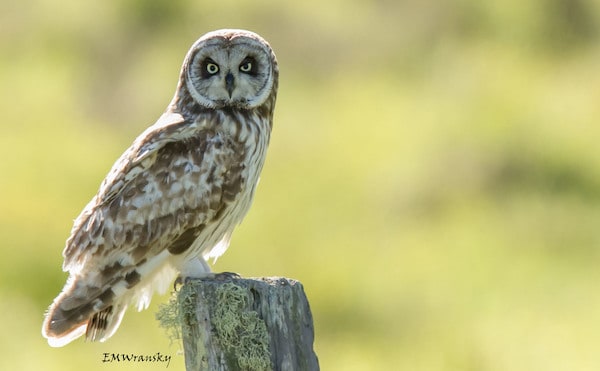
Scientific name: Asio flammeus sandwichensis
While the short-eared owl can be found in many places, this is a subspecies only found on the Hawaiian Islands. Often referred to as Pueo, these owls actually hunt during the day in open pastureland and forests so you have a decent chance of seeing one.
The Hawaiian Short-eared Owl has mottled brown and white plumage, with large, bright yellow eyes and short, feathered ear tufts. Their ear tufts are generally hard to see, so their head just appears round with dark patches around the eyes and a pale face.
You’ll likely see them perched on fenceposts or dead trees, or flying low over open fields. Although they are considered native to the islands, they did not live on the islands before people arrived. These owls eat mainly rodents, and before humans Hawaii’s only land mammals were bats, so they didn’t have a good enough food source. It is believed they only became a permanent resident to the islands after Polynesian rats arrived with Hawaii’s first settlers.
The Pueo is an important part of Hawaiian culture and mythology, and is considered a sacred bird by many Native Hawaiians. They are looked at as ‘aumakua, family guardian spirits. Unfortunately their numbers are declining due to factors including habitat loss, light pollution, and introduced mammals like the Indian mongoose that eat their eggs and young. On O’ahu they are considered an endangered species.
While you can get lucky in many areas of Maui, a good place to try your luck at seeing them is Hosmer Grove at Haleakala National Park.
36. Chukar

Scientific name: Alectoris chukar
The chukar partridges handsome plumage makes them pretty easy to identify. They have dusky brown and gray bodies, with black barring along their sides, a black stripe that circles across their eyes down to their chest, and a pink beak.
Chukar were introduced to Hawaii in the early 1920’s as a game bird. Originally they are native to Asia and eastern Europe. In the morning, you may hear their “cuck-chuck-chuck” call. Chukars preferred habitat is dry and rocky slopes in open areas with brush, scrub and sparse grass. They also like higher elevation, so you may see them along lookout trails and around parking lots at the top of Haleakala. Well adapted for this environment, they are agile on rocky terrain and fast, navigating with ease like a mountain goat.
To keep their feathers in tip-top shape in their dry environment, Chukars take daily dirt baths where they roll around on the ground in dusty soil. They are mainly ground foragers, looking for leaves and seeds of grasses.

